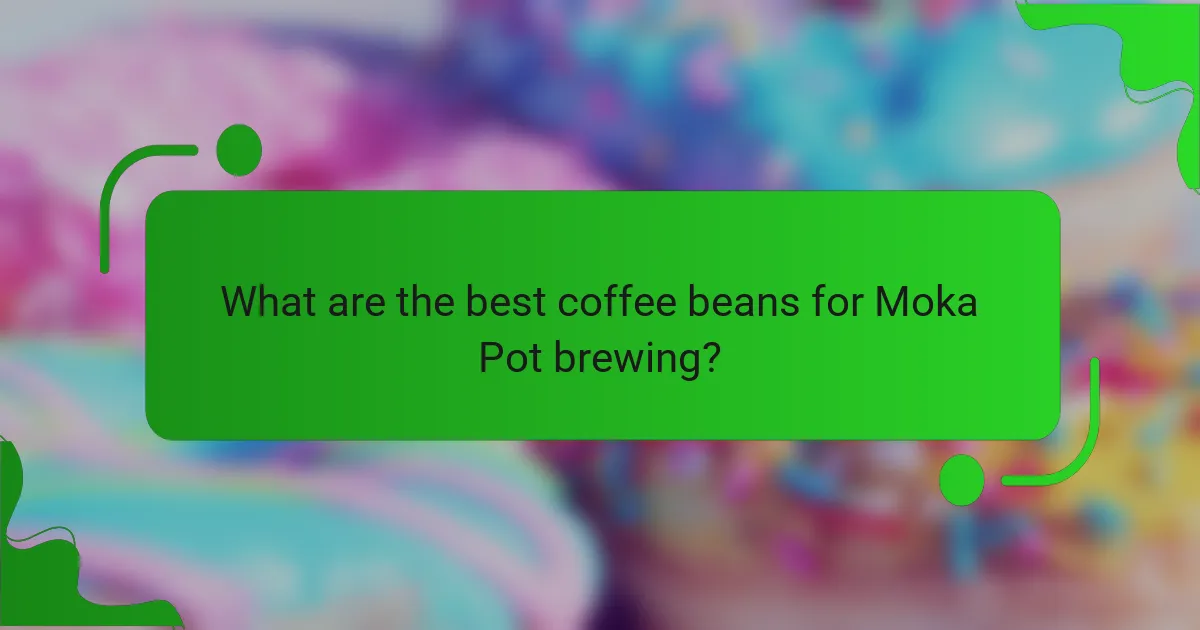The Moka Pot is a beloved brewing method that captures the essence of rich coffee flavors, especially in vibrant coffee cultures like Los Angeles. By mastering the right techniques and avoiding common pitfalls, you can elevate your coffee experience and savor a robust cup that truly reflects the quality of your beans. Selecting medium to dark roasts with a fine grind will further enhance the extraction, ensuring a delightful brew every time.

How to brew coffee with a Moka Pot in Los Angeles?
Brewing coffee with a Moka Pot in Los Angeles involves a straightforward process that highlights the rich flavors of the beans. With the right technique and attention to detail, you can enjoy a robust cup of coffee that reflects the local coffee culture.
Step-by-step brewing process
To brew coffee with a Moka Pot, start by filling the bottom chamber with water up to the safety valve. Next, place finely ground coffee in the filter basket, leveling it off without pressing down. Assemble the pot and place it on medium heat until you hear a hissing sound, indicating that coffee is being brewed.
Once brewing is complete, remove the pot from heat to prevent over-extraction. Allow the coffee to settle for a moment before pouring it into your cup. Enjoy your coffee straight or with milk, depending on your preference.
Recommended coffee grind size
The ideal grind size for Moka Pot coffee is similar to that of table salt or slightly finer. This consistency allows for optimal extraction during the brewing process. Avoid using a powdery grind, as it can clog the filter and lead to a bitter taste.
Experimenting with grind size can help you find the perfect balance for your taste. If the coffee tastes weak, try a finer grind; if it’s too bitter, opt for a coarser grind.
Ideal water temperature
The ideal water temperature for brewing coffee in a Moka Pot is around 90-95°C (194-203°F). Using water that is too hot can lead to over-extraction, resulting in a bitter flavor, while water that is too cool may under-extract, producing a weak brew.
To achieve the right temperature, you can preheat the water before adding it to the Moka Pot. This technique helps maintain consistent brewing conditions and enhances the overall flavor of your coffee.
Brewing time for optimal flavor
The brewing time for a Moka Pot typically ranges from 4 to 6 minutes. The exact time may vary based on your stove’s heat setting and the amount of coffee being brewed. Keeping an eye on the brewing process is essential to prevent over-extraction.
Listen for the hissing sound, which indicates that the coffee is almost ready. Once the sound changes to a gurgling noise, it’s time to remove the pot from the heat to preserve the flavor profile.

What are the common mistakes when using a Moka Pot?
Common mistakes when using a Moka Pot can lead to subpar coffee and frustration. Key issues include using the wrong grind size, overheating the pot, and improper cleaning, all of which can affect the flavor and performance of your brew.
Using incorrect grind size
The grind size of your coffee is crucial for optimal extraction in a Moka Pot. A grind that is too fine can clog the filter and create excessive pressure, while a grind that is too coarse may lead to weak coffee. Aim for a medium-fine grind, similar to table salt, to achieve the best balance.
To avoid issues, consider using a burr grinder for consistent results. If you’re unsure, start with a slightly coarser grind and adjust based on your taste preferences.
Overheating the pot
Overheating the Moka Pot can scorch the coffee and produce a bitter taste. It’s best to use medium heat and monitor the brewing process closely. Once you hear a hissing sound, it’s a sign that the coffee is almost ready.
To prevent overheating, consider using a heat diffuser if you’re on a gas stove. This can help distribute heat evenly and reduce the risk of burning the coffee.
Not cleaning the Moka Pot properly
Proper cleaning of the Moka Pot is essential to maintain its performance and flavor quality. Residue from previous brews can lead to off-flavors and clogging. After each use, disassemble the pot and rinse all parts with warm water, avoiding soap which can leave a residue.
For deeper cleaning, periodically soak the components in a vinegar solution to remove any built-up oils. Ensure all parts are thoroughly dried before reassembling to prevent rust and maintain longevity.

What are the best coffee beans for Moka Pot brewing?
The best coffee beans for Moka Pot brewing are typically medium to dark roasts, as they provide a rich and bold flavor that complements the brewing method. Look for beans that are finely ground, as this will enhance extraction and result in a more flavorful cup.
Recommended brands for Moka Pot
Several brands are known for producing high-quality coffee beans suitable for Moka Pot brewing. Popular choices include Lavazza, Illy, and Kimbo, which offer blends specifically designed for espresso-style brewing. These brands often provide options that balance acidity and sweetness, ideal for the Moka Pot’s unique extraction process.
Additionally, local roasters may offer fresh, single-origin beans that can elevate your Moka Pot experience. Look for roasters that provide detailed tasting notes to find a flavor profile that suits your palate.
Flavor profiles to consider
When selecting coffee beans for Moka Pot brewing, consider flavor profiles that enhance the brewing method’s characteristics. Beans with chocolate, nutty, or caramel notes often work well, as they can create a smooth and balanced cup. Avoid overly acidic beans, as they may result in a sharp taste that doesn’t complement the Moka Pot’s brewing style.
Experimenting with different blends can also yield interesting results. For instance, a blend of Arabica and Robusta beans can provide a fuller body and a richer crema, enhancing the overall flavor experience. Aim for beans that have been roasted within the last few weeks for optimal freshness and flavor extraction.

How does a Moka Pot compare to other brewing methods?
A Moka Pot offers a unique brewing experience that differs significantly from other methods like the French Press and espresso machines. It produces a strong, espresso-like coffee using steam pressure, making it a popular choice for those seeking rich flavor without the complexity of an espresso machine.
Moka Pot vs French Press
The Moka Pot and French Press both brew coffee but do so in distinct ways. The Moka Pot uses steam pressure to push water through coffee grounds, resulting in a concentrated brew, while the French Press relies on steeping coffee grounds in hot water, producing a fuller-bodied drink.
When using a French Press, the coffee typically has a coarser grind and is steeped for about four minutes. In contrast, Moka Pot coffee is brewed quickly, usually within five minutes, and requires a finer grind. This difference affects the flavor profile, with Moka Pot coffee being more intense and French Press coffee being smoother.
Moka Pot vs Espresso Machine
While both the Moka Pot and espresso machine aim to create strong coffee, they differ in their brewing methods and results. An espresso machine uses high pressure (around 9 bars) to extract coffee, while the Moka Pot operates at lower pressure, producing a coffee that is rich but not quite as concentrated as true espresso.
Espresso machines require more investment and maintenance, often costing hundreds of dollars, whereas Moka Pots are typically affordable, ranging from $20 to $50. For those who enjoy the espresso experience without the high cost and complexity, the Moka Pot is an excellent alternative.

What are the benefits of using a Moka Pot?
The Moka Pot offers several advantages for coffee enthusiasts, including rich flavor extraction, a compact design, and affordability compared to traditional espresso machines. These features make it a popular choice for brewing strong, aromatic coffee at home or on the go.
Rich flavor extraction
The Moka Pot is renowned for its ability to extract bold flavors from coffee grounds. It uses steam pressure to push hot water through the coffee, resulting in a concentrated brew that captures the essence of the beans. This method often produces a coffee that is richer and more robust than standard drip brewing.
To achieve optimal flavor, use freshly ground coffee with a medium-fine grind size. The ideal coffee-to-water ratio typically ranges from 1:7 to 1:10, depending on personal taste preferences. Experimenting with different beans can also enhance the flavor profile.
Compact and portable design
One of the standout features of the Moka Pot is its compact and portable design, making it an excellent choice for travel or small kitchens. Most models are lightweight and easy to pack, allowing coffee lovers to enjoy their favorite brew anywhere.
When selecting a Moka Pot for portability, consider sizes ranging from 1 to 6 cups. Smaller pots are ideal for solo travelers, while larger ones can serve multiple people without taking up much space. This versatility makes it a practical option for camping or road trips.
Affordability compared to espresso machines
The Moka Pot is significantly more affordable than traditional espresso machines, often costing less than $50. This low price point makes it accessible for those who want to enjoy espresso-like coffee without a hefty investment.
In contrast, entry-level espresso machines typically start around $100 and can go well into the thousands for high-end models. The Moka Pot provides an economical alternative without sacrificing flavor, making it a smart choice for budget-conscious coffee drinkers.

How to maintain and clean a Moka Pot?
Maintaining and cleaning a Moka Pot is essential for preserving its functionality and ensuring great-tasting coffee. Regular cleaning prevents residue buildup and keeps the brewing process efficient.
Daily cleaning tips
After each use, disassemble the Moka Pot and rinse all parts with warm water. Avoid using soap, as it can leave a residue that affects flavor. Ensure that the filter and rubber gasket are free from coffee grounds to maintain optimal performance.
Dry all components thoroughly before reassembling to prevent moisture buildup, which can lead to mold. Store the Moka Pot in a dry place to keep it in good condition.
Deep cleaning techniques
For deep cleaning, perform this process every few weeks or when you notice a change in taste. Start by soaking the parts in a mixture of equal parts water and vinegar for about 30 minutes to dissolve any stubborn buildup.
After soaking, scrub the components gently with a soft brush or cloth. Rinse thoroughly with warm water to remove any vinegar residue. Ensure all parts are completely dry before reassembling to avoid any moisture-related issues.

What are the historical origins of the Moka Pot?
The Moka Pot, invented in Italy in the 1930s by Alfonso Bialetti, revolutionized home coffee brewing. Its design was inspired by traditional Italian coffee-making methods, combining practicality with a unique aesthetic that has endured through decades.
How does the Moka Pot work?
The Moka Pot operates on a simple principle of steam pressure. Water in the bottom chamber is heated, creating steam that forces water up through the coffee grounds in the middle chamber, resulting in brewed coffee in the top chamber.
To use a Moka Pot effectively, fill the bottom chamber with water up to the safety valve, add finely ground coffee to the filter basket without pressing it down, and assemble the pot tightly. Heat it on medium-low to avoid burning the coffee.
What should you consider for authentic flavor?
For authentic flavor, use fresh, high-quality coffee beans and grind them just before brewing. The grind size should be finer than for drip coffee but coarser than espresso, allowing for optimal extraction without clogging the filter.
Water quality also impacts flavor; use filtered water to avoid unwanted tastes. Experiment with different coffee origins and blends to find your preferred flavor profile, as the Moka Pot enhances the coffee’s natural characteristics.
What are common pitfalls when using a Moka Pot?
One common pitfall is using too much heat, which can scorch the coffee and produce a bitter taste. Always start with medium-low heat and adjust as necessary. Additionally, overfilling the coffee basket can lead to poor extraction and a messy brew.
Another issue is not cleaning the Moka Pot regularly. Residue from previous brews can affect the taste of your coffee. Disassemble the pot after each use and wash it with warm water, avoiding soap to preserve the flavor integrity.



